Heard it from a Scout: The ultimate summer camping guide
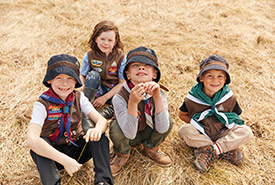
Scouts learn essential outdoor skills and how to prioritize safety in all activities. (Photo by Scouts Canada)
The perfect temperature for summer camping, according to Scouts — Canada’s youngest outdoor experts — is 27 C. So, go check your thermometer. It’s time to answer the call of the wilderness!
Scouts learn essential outdoor skills and how to prioritize safety in all activities, from day hikes to week-long portage tours. Prepare for your next camping trip — whether it’s the first or the 50th — just like a Scout, with Scouts Canada’s ultimate summer camping guide. Make your adventure both memorable and safe.
Campfire construction
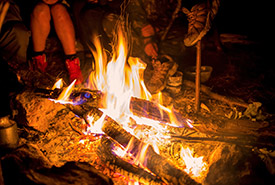
For many, a campfire is a beloved tradition. (Photo by Scouts Canada)
For many, a campfire is a beloved tradition. The first things that come to mind when thinking of a campfire are laughing, roasting hot dogs and sharing stories around crackling flames. Before building a campfire, though, make sure to check for any fire restrictions in the area.
The best fires are made up of three things:
- Tinder: Small twigs, dry leaves, needles, bark, wood shavings, paper or even dryer lint. These burn immediately and are a crucial element to spark a fire.
- Kindling: Sticks as thick as fingers help build a strong foundation.
- Firewood: Logs of wood keep the fire burning long into the night. Make sure to never move firewood.
Collect plenty of dry wood before striking a match so the fire isn’t left unattended to gather more fuel. If the campsite has a designated fire pit, use it to keep the flames contained. If it doesn’t, build the fire away from brush, branches and tents, on a durable surface like a rock, dirt or sand to prevent scorching the earth. Always have water close by to extinguish the fire.
Related blog posts
Animal encounters
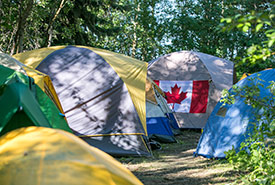
You're venturing into animal territory when camping. (Photo by Scouts Canada)
You’re venturing into animal territory when camping. Knowing before you go what types of wildlife reside in the area will help you prepare for and avoid animal encounters. Check for reports of recent sightings and keep an eye out for signs of wildlife nearby, such as tracks, fresh droppings, scratches on tree trunks or animal homes.
Be particularly cautious to protect yourself against ticks: tiny arachnids typically found in grassy, wooded areas or along shorelines and in parks — all places campers like to go! Some ticks can be carriers of illnesses, including Lyme disease.
To prevent a tick bite, wear long sleeves and tuck your pants into your socks so they can’t crawl in. Use bug spray with DEET and wear light clothing so ticks are easier to spot. Always do a thorough check all over your body for ticks, and continue to check because ticks can stay attached for five or more days.
If you are bitten by a tick, remove it carefully with tweezers by pulling upward with steady, even pressure, clean the area well and watch for signs, including a bull’s-eye-shaped rash. Seeing a doctor is recommended, as early detection is key. Symptoms of Lyme disease may not appear for weeks or even months after being bitten! Make sure to save the ticks in a clean container and contact a local public health unit. As Lyme disease spreads to more ticks, it is increasingly important that ticks be identified and tested.
First ow, first aid
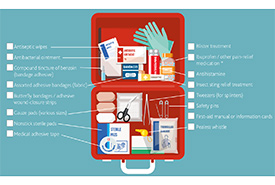
First aid checklist (Image by Scouts Canada)
Before heading out on any camping adventure, make sure your supplies include a fully-stocked first aid kit. Scouts use this checklist of items so they’re prepared for anything:
- antiseptic wipes
- antibacterial ointment
- bandage adhesive
- assorted adhesive bandages (fabric)
- butterfly bandages/adhesive wound-closure strips
- gauze pads (various sizes)
- non-stick sterile pads
- medical adhesive tape
- blister treatment
- Ibuprofen/other pain-relief medication
- antihistamine
- insect sting relief treatment
- tweezers (for splinters and tick removal)
- safety pins
- first aid manual or information cards
- pealess whistle
Scout-recommended adventure activities
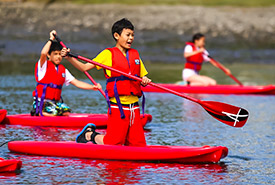
Paddleboarding provides stunning views of nature. (Photo by Scouts Canada)
Adventurous activities go hand-in-hand with camping, and prioritizing safety is essential to a great trip. Here are a few Scout favourites:
- Canoeing, kayaking and paddleboarding provide stunning views of nature, but even on a clear day, safety is key. Always paddle within your capabilities, wear a life jacket, bring an emergency kit, tell someone where you’re going and stay close to land when possible. Also, there is a difference between a lifejacket and personal flotation device (PFD): a lifejacket will turn most people over to keep their faces out of the water even if they lose consciousness. A PFD will not.
- Stargazing is of the most beautiful parts of going camping and a perfect opportunity to learn about constellations and the mysteries of the night sky.
- Swimming is the best way to cool off on a hot sunny day. Always swim in a group, avoid rough water and strong currents, and wear a lifejacket or PFD if you’re not a strong swimmer. Don’t forget to re-apply sunscreen!
- When hiking, watch out for hazardous plants like poison ivy. Remember: leaves of three, let it be! No one plans to get lost, but it can happen even on a short walk. Always bring a daypack with emergency supplies, including extra water, snacks, headlamp, first aid kit and emergency blanket.
Leave no trace
One rule Scouts always follow is “leave no trace.” This means not disturbing nature while enjoying the outdoors. Plan trips to ensure waste is packed up and disposed of properly, invasive species are not brought into the campsite and wildlife isn’t disturbed by excessive noise, light or garbage. Leave nature exactly as you found it.

